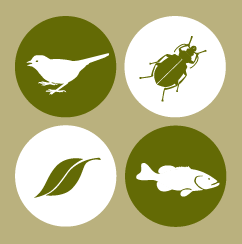Organisms, Populations, and Communities Data Theme

Organisms, Populations, and Communities data theme
The study of organisms, populations and communities examines how organisms interact with each other and their environment at individual, population and community levels. To characterize these interactions, NEON quantifies and observes interactions among multiple organisms and their environments. By sampling a variety of organisms in aquatic and terrestrial systems, NEON provides data on individual traits, population dynamics and the composition of communities. Integrated with other data collected across NEON sites, the project produces data in the areas of biodiversity, infectious diseases and invasive species.
NEON organisms, populations and communities data
NEON measures a variety of aquatic and terrestrial organisms that span a broad range of body sizes and lifespans, including:
- Microbes
- Plankton
- Algae
- Aquatic macroinvertebrates
- Mosquitoes
- Ticks
- Ground beetles
- Fish
- Small mammals
- Breeding landbirds
- Plants
NEON uses these measurements to produce data on abundance, phenology, taxonomic diversity and the prevalence of tick, mosquito and rodent-borne pathogens. Standardized data collected about organisms, populations and communities, may be combined with environmental data, such as precipitation and temperature data, to understand the causes and effects of significant environmental changes.
Ecological relevance
Populations and communities of organisms influence and support ecosystem processes and provide ecosystem services, such as:
- Carbon storage;
- Air and water filtration;
- Regulation of zoonotic diseases;
- Pollination essential for food production; and
- Recreation opportunities.
Successful ecosystem management requires an understanding of the interactions between organisms and the physical environment. The broad space and time scales of NEON’s organismal measurements, together with data provided through tower measurements, aquatic sensors and remote sensing, enables better understanding and management of the environment.
Research applications
NEON colocates organism, population and community measurements with other scientific measurements, providing a unique opportunity to examine ecological change across relevant space and time scales. NEON data may be used to address complex ecological questions, such as:
- How does land cover around agricultural areas influence ecosystem services like pollination and pest suppression?
- What factors regulate biodiversity?
- How is ecosystem function affected by changes in biodiversity?
- How can we protect and conserve biodiversity?
- How do changes in climate influence the spread of invasive species, loss of species and incidence of infectious diseases?
Key categories of measurements
- Organisms: size measurements, taxonomy and infection by pathogens
- Populations: abundance, phenology and pathogen prevalence